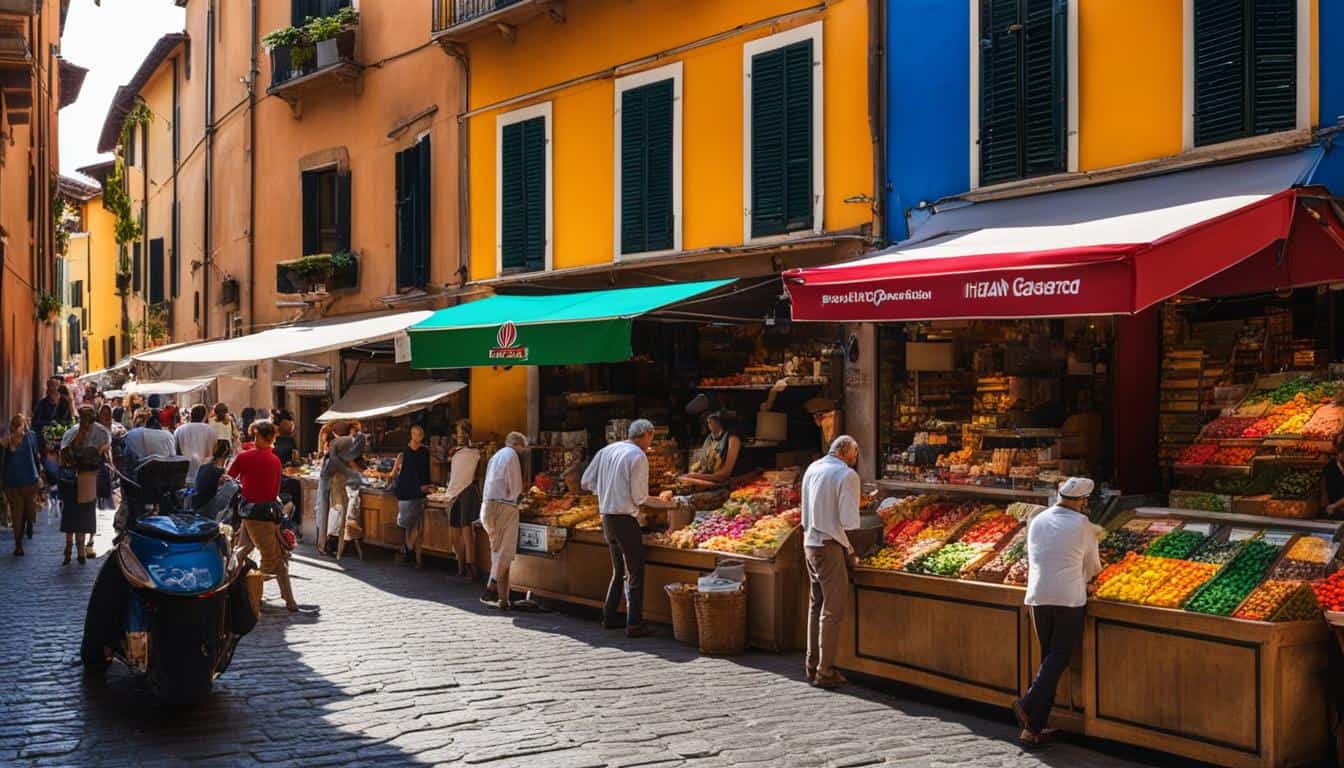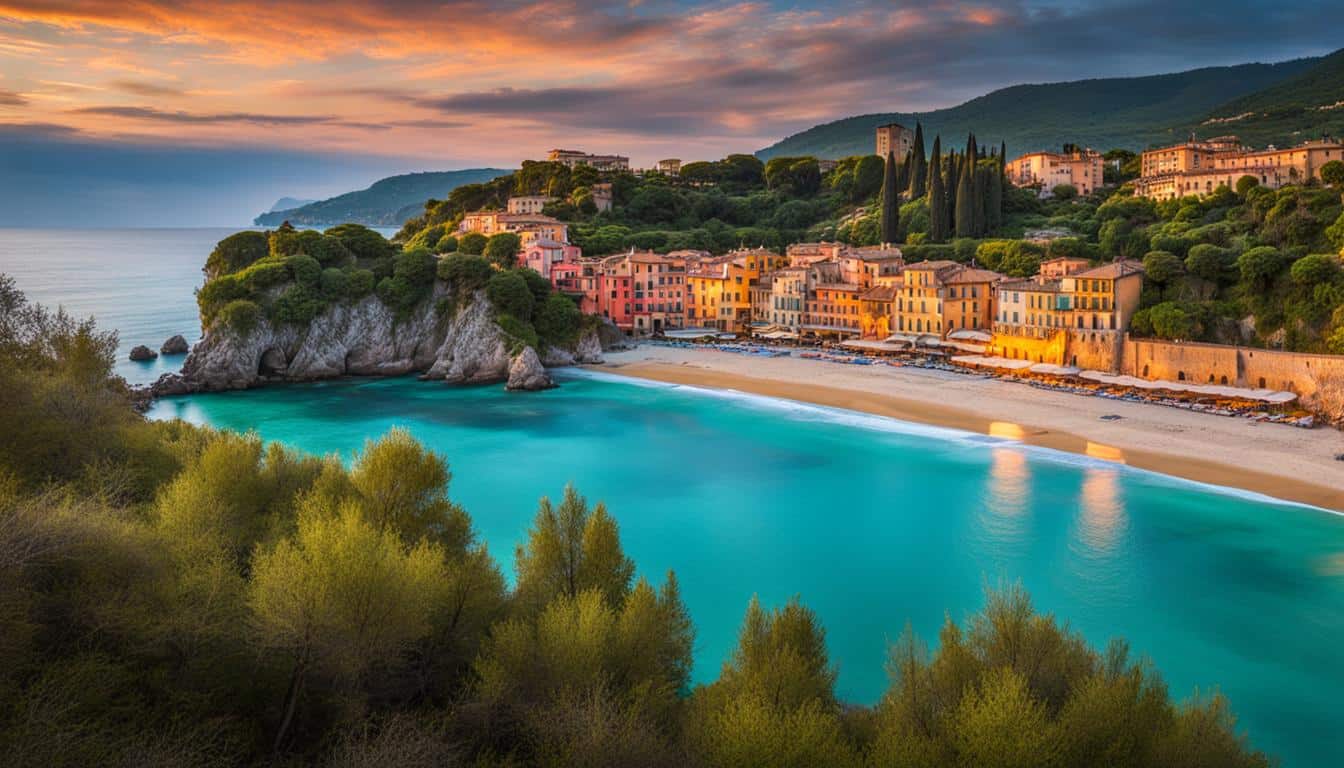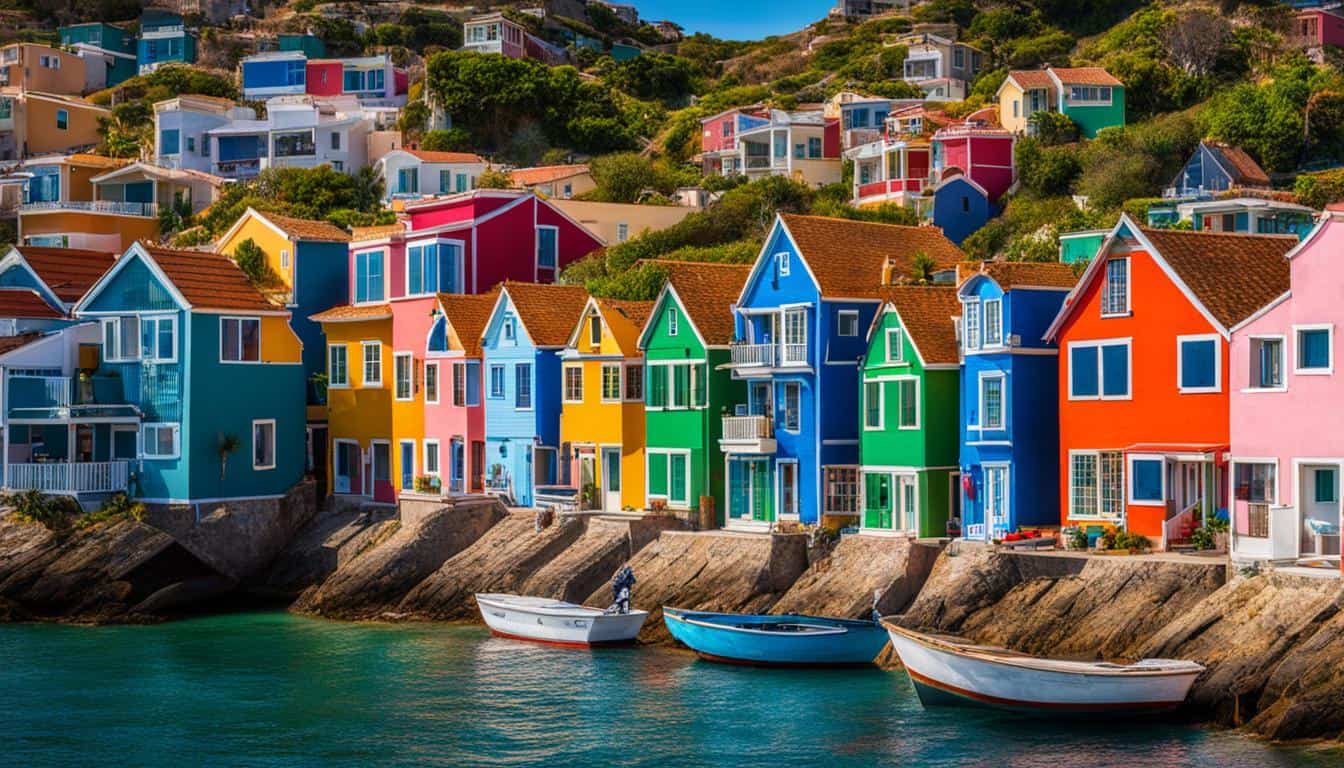Italy is a dream destination with its breathtaking cities and enchanting towns. Whether you’re wandering the charming streets, exploring the idyllic islands, or savoring the delectable gelato, there’s so much to discover in this beautiful country. To ensure an unforgettable and hassle-free trip to Italy, here are some essential travel tips and advice.
Key Takeaways:
- Download offline maps to navigate the narrow and winding streets of Italian cities.
- Explore the alluring islands of Italy, such as Sicily and Sardinia.
- Indulge in the mouthwatering delight of authentic Italian gelato.
- Take advantage of free drinking water available in town squares to save money.
- Embrace the relaxed dinner culture and savor the moment while enjoying Italian cuisine.
Download Offline Maps for Navigation
When exploring the charming cities of Italy, such as Venice and Florence, it’s easy to get lost in the narrow and winding streets. To navigate the Italian streets with ease, it’s a good idea to download offline maps on your smartphone or use the offline feature on apps like Google Maps.
Having an offline map handy allows you to access directions, search for nearby attractions, and find your way back to your hotel or any other destination. With an offline map, you don’t have to worry about losing your way or struggling to communicate with locals for directions.
By utilizing offline maps, you can confidently navigate the streets of Italy, whether you’re exploring the hidden corners of Venice or discovering the artistic treasures of Florence. So before embarking on your Italian adventure, make sure to download the necessary maps to ensure a hassle-free and enjoyable journey.
The benefits of offline maps for navigating Italian streets:
- Access directions and search for nearby attractions
- Find your way back to your hotel or any other destination
- Eliminate the need to rely on internet connectivity
- Ensure a hassle-free and enjoyable journey
Explore the Islands of Italy
Italy is not just about the mainland. It’s also home to numerous beautiful islands that offer their own unique charm and attractions. Whether you’re looking for pristine beaches, ancient ruins, or picturesque landscapes, the islands of Italy have it all. Two of the most popular islands to explore are Sicily and Sardinia.
Sicily, located off the southern coast of Italy, is the largest island in the Mediterranean Sea. It’s known for its rich history, stunning architecture, and mouthwatering cuisine. From the iconic Mt. Etna volcano to the ancient Greek ruins of Agrigento, Sicily is a treasure trove of cultural and natural wonders.
Sardinia, on the other hand, is a paradise for nature lovers. With its crystal-clear turquoise waters and white sandy beaches, it’s easy to see why this island is a favorite among travelers. Sardinia is also home to the breathtaking Costa Smeralda, a stretch of coastline known for its luxury resorts and vibrant nightlife.
| Island | Main Attractions |
|---|---|
| Sicily | Mount Etna, Valley of the Temples, Taormina |
| Sardinia | Costa Smeralda, Maddalena Archipelago, Su Nuraxi |
No matter which island you choose to explore, you’re bound to be mesmerized by the natural beauty, rich history, and warm hospitality that Italy’s islands have to offer. So pack your bags, hop on a ferry or a short domestic flight, and embark on an unforgettable island adventure in Italy.
Indulge in Gelato
Italy is famous for its delicious gelato, and no trip to Italy is complete without trying this frozen treat. Gelato is a traditional Italian ice cream that is known for its rich and creamy texture. It is made with high-quality ingredients, including fresh milk, cream, sugar, and various flavors. From classic flavors like pistachio and chocolate to unique combinations like stracciatella and limone, there is a gelato flavor for everyone to enjoy.

When in Italy, make sure to visit local gelaterias and indulge in this sweet delight. Gelato shops can be found on almost every street, and they often have a wide selection of flavors on display. Take your time and savor each scoop as you explore the different flavors and find your favorite. Whether you prefer a cone or a cup, gelato is a delightful treat that will satisfy your sweet tooth and keep you cool on hot summer days.
Not all Gelato is Created Equal
While gelato is available throughout Italy, it’s important to note that not all gelato is created equal. To ensure you are getting the best gelato experience, look for gelaterias that use high-quality ingredients and make their gelato fresh daily. Avoid places that have vibrant and unnatural colors, as they often use artificial additives. Instead, opt for gelato shops that have more muted colors, as they are more likely to use natural ingredients.
Top Gelato Spots in Italy
If you’re looking for the best gelato in Italy, here are some top spots to visit:
- Gelateria Santa Trinita – Florence
- Gelato di San Crispino – Rome
- Gelateria Dondoli – San Gimignano
- Gelateria La Romana – Bologna
- Grom – Various locations throughout Italy
These gelaterias are known for their exceptional gelato quality and a wide range of flavors. Don’t miss the opportunity to try their specialties and experience the true flavors of Italy.
Take Advantage of Free Drinking Water
When exploring the beautiful cities of Italy, it’s important to stay hydrated, especially during the warmer months. Fortunately, Italy offers a convenient and cost-effective solution for quenching your thirst – free drinking water fountains. In cities like Rome, Florence, and Venice, you’ll find numerous public fountains that provide clean and safe drinking water.
These fountains, known as “nasoni” in Rome, are typically found in town squares and other public spaces. They are easy to spot with their distinctive designs and flowing water. You can either bring a reusable water bottle or refill your store-bought bottle at these fountains, allowing you to stay refreshed throughout your adventures in Italy.
Not only is drinking from these fountains a sustainable choice, but it can also help you save money on buying bottled water. Instead, you can use the extra Euros to indulge in more gelato or treat yourself to a memorable experience.
| City | Location |
|---|---|
| Rome | Piazza Navona |
| Florence | Piazza della Signoria |
| Venice | Piazza San Marco |
So, next time you’re exploring the charming streets of Italy, don’t forget to keep an eye out for these free drinking water fountains. Stay hydrated, save money, and make the most of your Italian adventure!
Disclaimer: Please note that water fountain availability and locations may vary. It’s always a good idea to check with local authorities or tourism information centers for the most up-to-date information.
Embrace the Relaxed Dinner Culture
One of the highlights of visiting Italy is experiencing the country’s relaxed dinner culture. Italians view dinner as a time to unwind, savor delicious food, and enjoy the company of friends and family. Unlike in some other countries where meals may be rushed, in Italy, dinner is a leisurely affair that can last for several hours.
When dining in Italy, it’s important to embrace the slow-paced nature of the meal. Take your time and savor each course, allowing yourself to truly appreciate the flavors and aromas of authentic Italian cuisine. Engage in conversation with your dining companions, and soak up the warm and welcoming atmosphere that Italians create during dinner.
It’s also worth noting that dinner in Italy typically begins later than in many other countries. It’s common for Italians to enjoy their evening meal around 8 p.m. or even later. So, don’t be surprised if you find restaurants relatively empty before this time. Use the extra time to explore the city or relax with an aperitivo before dinner.
Italian Dinner Etiquette
While dining in Italy, it’s helpful to familiarize yourself with some basic dinner etiquette. Italians take their meals seriously and have certain customs that are worth respecting. Here are a few tips to keep in mind:
- Wait to be seated: It’s customary to wait to be seated by the restaurant staff rather than choosing your own table.
- Ordering courses: In Italy, meals are typically served in multiple courses. Start with antipasti (appetizers), followed by primi piatti (first courses), such as pasta or risotto, and then secondi piatti (main courses), usually meat or fish. Don’t forget to leave room for dolci (dessert)!
- Bread and butter: Italians often eat bread as an accompaniment to their meal. However, it’s considered impolite to eat bread with butter during a meal. Instead, you can dip your bread in olive oil or enjoy it on its own.
- Tipping: In Italy, tipping is not as common as in other countries. A service charge may already be included in your bill. If not, it’s customary to leave a small amount as a gesture of appreciation.
By embracing the relaxed dinner culture in Italy and adhering to local customs, you can enhance your dining experience and fully immerse yourself in the Italian way of life.
| Italian Dinner Culture | Key Points |
|---|---|
| Leisurely Affair | Embrace the slow-paced nature of dinner and enjoy the company of friends and family for several hours. |
| Timing | Dinner in Italy usually begins around 8 p.m. or later, so plan your evening accordingly. |
| Etiquette | Respect Italian dinner customs, such as waiting to be seated, ordering courses, and understanding tipping practices. |
Card Payments Accepted
When traveling in Italy, one of the convenient aspects is that card payments are widely accepted, including credit cards. This means you can easily make purchases using your card without the need for large amounts of cash. Whether you’re visiting popular tourist attractions, dining at local restaurants, or indulging in some retail therapy, you’ll find that most establishments in Italy are equipped with card payment facilities.
Having the option to pay by card provides a level of convenience and security. You don’t have to worry about carrying large amounts of cash or exchanging currency. It’s also a more efficient way of keeping track of your expenses, as you’ll have a record of all your transactions. However, it is still advisable to carry some cash for smaller purchases or in case you encounter places that prefer cash payments.
It’s important to note that while card payments are generally accepted in Italy, there may still be some smaller stores or businesses that only accept cash. Additionally, it’s recommended to inform your bank or credit card provider about your travel plans to avoid any issues with your card being blocked for suspicious activity while you’re abroad.
So, whether you’re exploring the historic streets of Rome, shopping in the fashion capital of Milan, or enjoying the breathtaking landscapes of Tuscany, you can rely on card payments to make your transactions hassle-free in Italy.

Explore Italy’s Impressive Beaches
Italy is not just renowned for its exquisite cities and cultural treasures; it is also home to some of the most breathtaking beaches in the world. From the northern coastline of Liguria to the sun-kissed shores of Sicily in the south, Italy offers an array of stunning beach destinations that will leave you in awe.
Whether you’re seeking relaxation, water sports, or simply a picturesque escape, Italy has a beach to suit every preference. The Amalfi Coast, with its dramatic cliffs and turquoise waters, provides a picturesque backdrop for sunbathing and swimming. If you’re in search of a pristine white sand beach, head to the captivating island of Sardinia, where you’ll find world-renowned spots like Spiaggia della Pelosa and Cala Mariolu.
For those looking for a mix of natural beauty and vibrant atmosphere, the beaches of the Adriatic Sea are a must-visit. Rimini, with its golden sands and lively beach bars, offers a perfect blend of relaxation and entertainment. If you prefer a more secluded and tranquil beach experience, the serene coastlines of Puglia, such as Torre dell’Orso and Baia dei Turchi, provide a peaceful escape from the crowds.
| Beach Destination | Location | Highlights |
|---|---|---|
| Amalfi Coast | Southern Italy | Dramatic cliffs, crystal-clear waters |
| Sardinia | Island in the Mediterranean Sea | White sand beaches, turquoise waters |
| Rimini | Adriatic Coast | Golden sands, vibrant beach bars |
| Puglia | Southern Italy | Secluded coastlines, tranquil atmosphere |
So, whether you’re a beach lover or simply looking to bask in the beauty of Italy’s coastal landscapes, make sure to include a visit to one of its impressive beaches in your itinerary. Experience the sun, sand, and sea that have captivated travelers for centuries, and create lasting memories in the idyllic seaside settings that Italy has to offer.

Quotes:
“Italy’s beaches are a hidden gem waiting to be discovered. The combination of stunning natural beauty, crystalline waters, and warm Mediterranean climate make them a paradise for beach lovers.” – Travel Enthusiast Magazine
“From the luxurious resorts of the Amalfi Coast to the unspoiled coves of Sardinia, Italy offers a diverse range of beach experiences that cater to every traveler’s desires.” – Beach Travel Blog
Travel by Train Between Cities
When exploring Italy, traveling by train between cities is a convenient and efficient option. Italy boasts an impressive high-speed railway network that connects major cities across the country. Whether you’re planning to visit Rome, Florence, Venice, or other beautiful destinations, hopping on a train allows you to experience the diverse regions of Italy without the hassle of driving or navigating unfamiliar roads.
High-speed trains in Italy offer a comfortable and scenic journey, allowing you to sit back, relax, and enjoy the picturesque landscapes that pass by your window. These trains are equipped with modern amenities, such as spacious seating, onboard Wi-Fi, and food and beverage options, ensuring a pleasant travel experience.
Not only is train travel in Italy convenient, but it’s also eco-friendly. By opting for trains instead of cars or flights, you’re reducing your carbon footprint and contributing to a more sustainable way of exploring the country. So, if you’re conscious about the environment and want to minimize your impact while discovering Italy’s wonders, train travel is the way to go.
Benefits of Train Travel in Italy
- Efficiency: High-speed trains offer quick and direct connections between major cities, saving you time and allowing you to maximize your sightseeing.
- Convenience: Train stations are centrally located, making it easy to access tourist attractions and accommodations.
- Comfort: Trains provide spacious seating, ample legroom, and amenities like onboard Wi-Fi and food options.
- Picturesque Views: As you travel through the Italian countryside, you’ll be treated to breathtaking views of rolling hills, vineyards, and historic towns.
- Social Interaction: Train journeys provide an opportunity to meet fellow travelers from around the world, exchanging stories and making new friends.
Travel Tips for Train Travel in Italy
- Book in Advance: To secure the best fares and seat availability, it’s recommended to book your train tickets in advance, especially during peak travel seasons.
- Validate Your Ticket: Before boarding the train, make sure to validate your ticket using the machines available at the station or onboard. Failure to do so can result in fines.
- Keep Your Ticket Handy: Train tickets may be checked during your journey, so it’s important to keep your ticket easily accessible.
- Check the Schedule: Be aware of train schedules and departure platforms to ensure a smooth and timely journey.
- Consider a Rail Pass: If you plan to travel extensively within Italy, a rail pass can offer flexibility and cost savings. Research different pass options to find the one that suits your travel plans.
| City | Distance from Rome | Travel Time |
|---|---|---|
| Florence | 275 km | 1 hour 35 minutes |
| Venice | 528 km | 1 hour 55 minutes |
| Milan | 576 km | 2 hours 40 minutes |
| Naples | 230 km | 1 hour 10 minutes |
Validating Train/Bus Tickets in Italy: Avoiding Fines
When traveling by train or bus in Italy, it’s essential to validate your tickets to ensure a smooth and hassle-free journey. Failure to do so can result in fines if ticket inspectors catch you with an invalid or unvalidated ticket. To avoid any unnecessary penalties and potential complications, here’s what you need to know about validating train and bus tickets in Italy.
Train Tickets Validation:
When you purchase a train ticket in Italy, it usually comes as a blank ticket without a specific date or time. Before boarding the train, it’s crucial to find a validation machine, commonly located on the platforms or near the entrance. Insert your ticket into the machine and wait for it to be stamped with the travel date and time. This validation process is mandatory and helps ensure that you have a valid ticket for your intended journey.
Quote: “Validating train tickets is a simple step that can save you from unnecessary fines and potential inconvenience while traveling in Italy.” – Traveler’s Advice Magazine
Once your train ticket is validated, it is valid for a specific period depending on the type of ticket you purchased. Make sure to check the validity period before your journey to ensure you don’t exceed the allowed time. Additionally, if you have a ticket for a specific train, make sure to board the designated train as indicated on your ticket. Failure to do so may result in penalties even if your ticket is validated.
Bus Tickets Validation:
Similar to train tickets, bus tickets in Italy also need to be validated. However, the validation process for bus tickets may vary depending on the city or region. In some cities, like Rome, there are validation machines onboard the bus that you must use immediately after boarding. In other cities, validation machines may be located at the bus stops.
It’s important to note that some bus tickets are pre-validated and do not require further validation. These tickets usually have the date and time of purchase printed on them. However, if you’re unsure about whether or not your ticket is pre-validated, it’s best to validate it to avoid any possible penalties.
By taking the time to validate your train and bus tickets in Italy, you can ensure a smooth and stress-free journey without the worry of fines or complications. Remember to always carry a validated ticket with you throughout your travel, as inspectors may check for valid tickets at any time.
| Benefits of Ticket Validation | Consequences of Invalid Tickets |
|---|---|
|
|
Experience the Contrasting North and South
Italy’s unique geography creates a stark contrast between its northern and southern regions. These distinct areas offer visitors a diverse range of experiences, from the bustling cities of the north to the idyllic landscapes of the south.
In the north, you’ll find industrialized cities such as Milan, Turin, and Bologna, which have a more continental European feel. This region is known for its economic prosperity, fashion, and modern architecture. Take a stroll through the fashion capital of Milan, where designer boutiques line the streets, or visit the iconic Leaning Tower of Pisa in Tuscany.
On the other hand, the south of Italy has a more laid-back Mediterranean vibe. Here, you can explore charming coastal towns like Amalfi and Sorrento, with their picturesque landscapes and crystal-clear waters. The south is also home to historic sites such as Pompeii and the ancient city of Matera, where you can immerse yourself in the rich history and culture of the region.
Whether you choose to explore the north or the south, both regions have their own unique attractions and culinary delights. In the north, indulge in hearty dishes like risotto and polenta, while in the south, savor fresh seafood and delicious Neapolitan pizza.
So, whether you’re drawn to the cosmopolitan cities of the north or the laid-back charm of the south, experiencing the contrasting regions of Italy is a must for any traveler looking to delve into the country’s diverse culture and landscapes.
Conclusion
Traveling to Italy can be a memorable and enriching experience. To make the most of your time in this beautiful country, here are some essential Italy travel tips:
First and foremost, be prepared to get lost in the charm of Italian streets. Exploring the narrow and winding streets of cities like Venice and Florence is part of the adventure. Downloading an offline map on your smartphone or using Google Maps’ offline feature can help you navigate with ease.
Don’t forget to indulge in gelato! Italy is famous for its delicious frozen treat, and you’ll find gelato shops dotted throughout the streets. Treat yourself to this creamy delight and experience the true taste of Italy.
While in Italy, take advantage of the free drinking water available in town squares. You can fill up your reusable bottle or even your store-bought bottle, saving money on buying bottled water and staying hydrated throughout your travels.
Embrace the relaxed dinner culture in Italy. Dinner is a leisurely affair, meant to be enjoyed with friends and family. Take your time, savor the delicious Italian cuisine, and soak in the slow-paced atmosphere.
By following these best travel tips for Italy, you’ll be able to enhance your journey and create unforgettable memories in la dolce vita. So pack your bags, embrace the Italian lifestyle, and get ready for an amazing adventure!
FAQ
Are there offline maps available for navigating the streets of Italy?
Yes, you can download offline maps on your smartphone or use the offline feature on Google Maps to navigate the narrow and winding streets of Italian cities.
What islands should I explore in Italy?
Italy has numerous beautiful islands, including Sicily, Sardinia, Elba, and Levanzo. Each island offers unique charm and attractions worth discovering.
Where can I find delicious gelato in Italy?
Gelato can be found in most streets of Italy at affordable prices. Make sure to indulge in this frozen treat and experience the delicious flavors that Italy has to offer.
Can I drink tap water in Italian cities?
Yes, in cities like Rome, Florence, and Venice, there are clean and safe drinking water fountains in town squares. You can bring a reusable bottle or fill up your store-bought bottle with the free water.
What is the dinner culture like in Italy?
Dinner in Italy is a leisurely and relaxed affair. Take your time, savor delicious Italian cuisine, and enjoy the company of friends and family.
Are card payments widely accepted in Italy?
Yes, Italy has widely accepted card payments, including credit cards. However, it’s recommended to carry some cash for small purchases as some stores may have minimum spends or only accept cash.
Are there beautiful beaches in Italy?
Yes, Italy is home to stunning beaches along its impressive coastline. Make sure to visit places like Terracina and enjoy the beautiful white sand beaches.
Can I travel between cities in Italy by train?
Yes, Italy has an impressive high-speed railway network, making it convenient to travel between cities. Trains like Rome-Florence-Venice offer a quick and efficient way to explore different regions of Italy.
Do I need to validate my train/bus tickets in Italy?
Yes, when traveling by train or bus in Italy, it’s important to validate your tickets using the machines onboard or at the start of the platform. Failure to do so can result in a fine if inspectors catch you without a validated ticket.
What are the differences between the north and south of Italy?
The north and south of Italy have distinct cultural and economic differences. The north has an industrialized, continental European feel, while the south has a more laid-back Mediterranean vibe. Both regions offer their own unique experiences and attractions.
